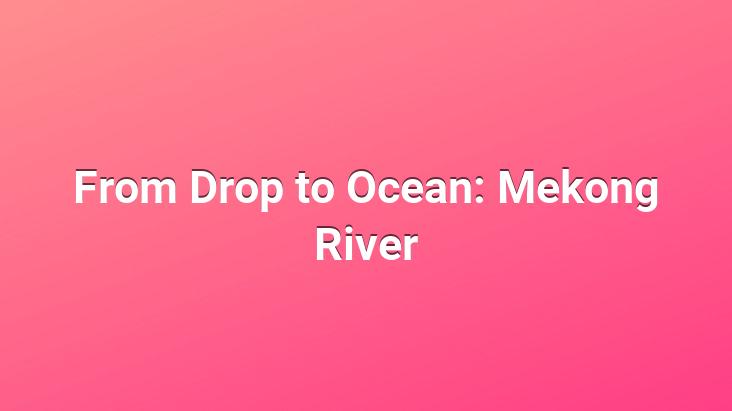Water is life, the lifeblood of Southeast Asia in Mekong. One of the largest rivers in the world, with a length of approximately 4350 km, it is among the top ten rivers of the world.. The adventure of this water or a drop starts from Tibet, from the eastern Himalayan Mountains, at an altitude of 5224 m, such as Yunnan (China), Myanmar, Laos, Thailand, Cambodia and Vietnam It is poured into the South China Sea, that is, the Pacific Ocean, by passing through 6 Southeast Asian countries. it gets interesting. The area covered by the river water is 795,000 km2, the six countries counted as the surface area of Turkey are partially the basin of this river system and the population living in this basin is 60 million.. It provides water for agriculture, especially rice fields, besides the inland waterways of the countries, it is the chief reflection of people who grow fishing and other aquaculture.. On the other hand, many rare, endemic creatures; Mekong freshwater dolphins, 300 kg giant Mekong Catfish live in these waters. The most interesting of all; It supplies the water of Tonle Sap, the largest natural lake in India. It fills 14 man-made dams and generates energy with hydroelectric power plants.. The delta is divided into numerous branches, forming a giant water labyrinth, river tributaries and coconut forests, as well as giant bridges, roads, cities, villages, factories, floating markets, river barges and ships, vendors, a sea of water welded to tourists Mekong River.
Every great civilization was founded and lived by giant rivers, Egypt by the Nile, Mesopotamia by the Tigris-Euphrates, Hindu by the Ganges, Angkor Civilization by the Mekong could come to life because of this.. At the height of its development, Angkor, with a population of more than one million; 12. It was the largest city in the world in the 13th century.. It was demolished for unknown reasons at the end of the century.. Angkor, this world wonder candidate ancient city, which was found by the imperialist colonial French before being swallowed by the tropical forests of Cambodia and Northern Thailand, is under the protection of UNESCO World Heritage List.
Mekong; Angkor justifies its civilization with its size, although it contains as much water as the Mississippi, the most interesting aspect of this river is that sometimes it can flow backwards, or 300 km from the South China Sea, like the Norwegian fjords.. as much land, that is, passing through Vietnam and into Cambodia.. This river flows in the tropics, surrounded by rainforest.. There is no winter season here, there is a rainy season and a dry season.. The rains coming from the pacific in May with monsoon affect the south of the Asian continent, it rains almost every day until October, the rains stop in the October-April period, the rivers stop, the waters decrease.. Depending on this phenomenon, the Mekong changes its current.
With the increase in temperature in April, snow and ice begin to melt in the Himalayas. Every creek, river, stream and tea in the basin, sometimes cascading and sometimes calmly flowing, meets the Mekong, grows as it meets, does not fit in its bed, it overflows.. As it overflows, it forms the flood plains of Southeast Asia, irrigating rice fields. It carries fishery products to the fields or even to the doorstep.
In monsoon season, some roads are closed and villages are filled with water. This process is indispensable for these lands, people provide their transportation by rafts or boats, their houses are made of bamboo poles, or a pontoon in the lake. they live by building on. The Mekong river also crosses its bed, where it meets the Tonle Sap river in Phnom Penh, using this river as a canal to drain the excess water into the Tonle Sap, the largest lake in Southeast Asia.. At this stage, the lake area enlarges 3-4 times, the remaining river water divides into the delta south of Phnom Penh.. It divides into numerous branches in the delta and empties into the sea.. This phenomenon is the normal adventure of the Mekong.. The real interesting phase in the Mekong begins in the dry season.
In November, the Himalayas are cold, some of the water freezes, becomes ice, and the water flowing into the Mekong decreases.. With the cessation of monsoons, the river can now flow in its bed. what discharges. The Cambodian flood plain is slightly above sea level in some places, so this river is like a fjord, starting from the sea to Phnom Penh, the capital of Cambodia, and Tonle Sap lake in the northwest, it is at the same level with the sea. With its amount of water and interesting flow direction, the Mekong is a wonder of the world, just like the ancient city of Angkor on its edge.. The main river, which provides 60% of the protein need of a country’s population with the aquatic products it contains, turns into an ocean in the Vietnamese delta, while it is a drop in Tibet. Issue:
Article: Mehmet Tahan
Photos: Kemal Kaya







